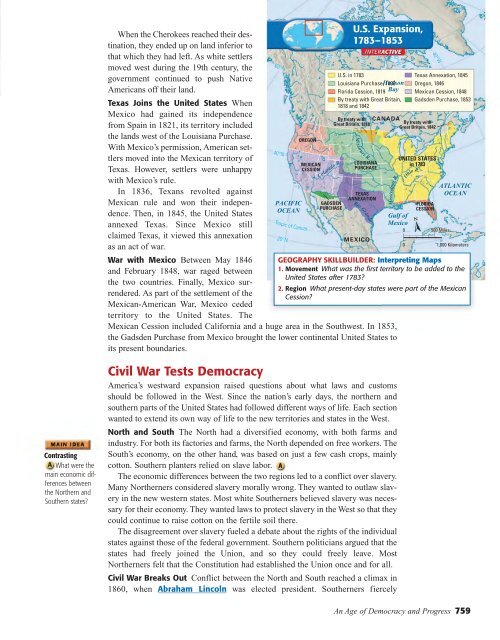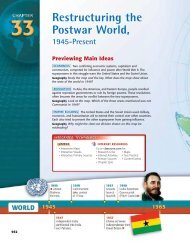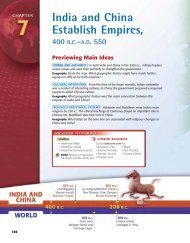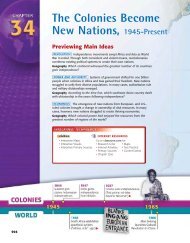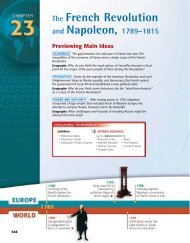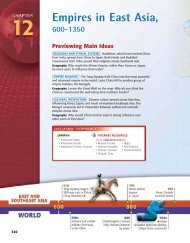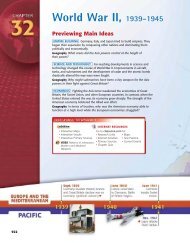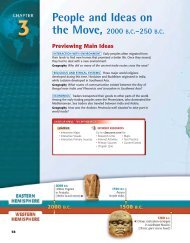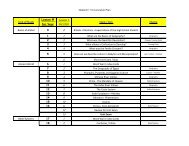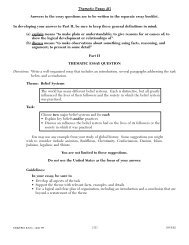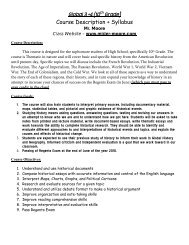The Industrial Revolution, 1700– 1900 Previewing Main Ideas
The Industrial Revolution, 1700– 1900 Previewing Main Ideas
The Industrial Revolution, 1700– 1900 Previewing Main Ideas
Create successful ePaper yourself
Turn your PDF publications into a flip-book with our unique Google optimized e-Paper software.
Contrasting<br />
What were the<br />
main economic differences<br />
between<br />
the Northern and<br />
Southern states?<br />
When the Cherokees reached their destination,<br />
they ended up on land inferior to<br />
that which they had left. As white settlers<br />
moved west during the 19th century, the<br />
government continued to push Native<br />
Americans off their land.<br />
Texas Joins the United States When<br />
Mexico had gained its independence<br />
from Spain in 1821, its territory included<br />
the lands west of the Louisiana Purchase.<br />
With Mexico’s permission, American settlers<br />
moved into the Mexican territory of<br />
Texas. However, settlers were unhappy<br />
with Mexico’s rule.<br />
In 1836, Texans revolted against<br />
Mexican rule and won their independence.<br />
<strong>The</strong>n, in 1845, the United States<br />
annexed Texas. Since Mexico still<br />
claimed Texas, it viewed this annexation<br />
as an act of war.<br />
War with Mexico Between May 1846<br />
and February 1848, war raged between<br />
the two countries. Finally, Mexico surrendered.<br />
As part of the settlement of the<br />
Mexican-American War, Mexico ceded<br />
territory to the United States. <strong>The</strong><br />
Mexican Cession included California and a huge area in the Southwest. In 1853,<br />
the Gadsden Purchase from Mexico brought the lower continental United States to<br />
its present boundaries.<br />
Civil War Tests Democracy<br />
America’s westward expansion raised questions about what laws and customs<br />
should be followed in the West. Since the nation’s early days, the northern and<br />
southern parts of the United States had followed different ways of life. Each section<br />
wanted to extend its own way of life to the new territories and states in the West.<br />
North and South <strong>The</strong> North had a diversified economy, with both farms and<br />
industry. For both its factories and farms, the North depended on free workers. <strong>The</strong><br />
South’s economy, on the other hand, was based on just a few cash crops, mainly<br />
cotton. Southern planters relied on slave labor.<br />
<strong>The</strong> economic differences between the two regions led to a conflict over slavery.<br />
Many Northerners considered slavery morally wrong. <strong>The</strong>y wanted to outlaw slavery<br />
in the new western states. Most white Southerners believed slavery was necessary<br />
for their economy. <strong>The</strong>y wanted laws to protect slavery in the West so that they<br />
could continue to raise cotton on the fertile soil there.<br />
<strong>The</strong> disagreement over slavery fueled a debate about the rights of the individual<br />
states against those of the federal government. Southern politicians argued that the<br />
states had freely joined the Union, and so they could freely leave. Most<br />
Northerners felt that the Constitution had established the Union once and for all.<br />
Civil War Breaks Out Conflict between the North and South reached a climax in<br />
1860, when Abraham Lincoln was elected president. Southerners fiercely<br />
60°N<br />
40°N<br />
PACIFIC<br />
OCEAN<br />
Tropic of Cancer<br />
20°N<br />
OREGON<br />
MEXICAN<br />
CESSION<br />
120°W<br />
Colorado R.<br />
GADSDEN<br />
PURCHASE<br />
U.S. Expansion,<br />
1783–1853<br />
100°W<br />
Missouri R.<br />
Río Grande<br />
80°W<br />
U.S. in 1783<br />
Louisiana Purchase, Hudson 1803<br />
Florida Cession, 1819 Bay<br />
By treaty with Great Britain,<br />
1818 and 1842<br />
By treaty with<br />
Great Britain, 1818<br />
LOUISIANA<br />
PURCHASE<br />
TEXAS<br />
ANNEXATION<br />
MEXICO<br />
Mississippi R.<br />
Ohio R.<br />
An Age of Democracy and Progress 759<br />
40°W<br />
CANADA By treaty with<br />
Great Britain, 1842<br />
Texas Annexation, 1845<br />
Oregon, 1846<br />
Mexican Cession, 1848<br />
Gadsden Purchase, 1853<br />
UNITED STATES<br />
in 1783<br />
FLORIDA<br />
CESSION<br />
Gulf of<br />
Mexico<br />
0 500 Miles<br />
ATLANTIC<br />
OCEAN<br />
0 1,000 Kilometers<br />
GEOGRAPHY SKILLBUILDER: Interpreting Maps<br />
1. Movement What was the first territory to be added to the<br />
United States after 1783?<br />
2. Region What present-day states were part of the Mexican<br />
Cession?


